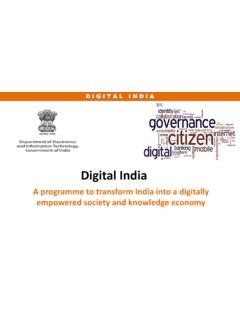Transcription of MEASURING SMART CITIES’ PERFORMANCE
1 MEASURING SMART cities PERFORMANCEDo SMART cities benefit everyone?Scoping note2nd OECD Roundtable on SMART cities and Inclusive Growth3 December 20202 | Table of contents 1 MEASURING SMART cities PERFORMANCE : Do SMART cities benefit everyone? 3 Why measure SMART cities PERFORMANCE ? 3 What existing measurement frameworks of SMART cities tell us 5 What can the OECD bring? 6 2 Proposal for an OECD SMART City Measurement Framework 9 What does the OECD SMART City Measurement Framework aim to assess? 9 Pillar 1: SMART city tools 10 Pillar 2: Stakeholder engagement for SMART cities 11 Pillar 3: SMART city PERFORMANCE 13 Next steps: developing and implementing the measurement framework 14 References 16 | 3 While many cities have joined the SMART city wave over the past two decades, digitalisation has taken centre stage over the past few months to shelter cities from the ever-persistent COVID-19 pandemic.
2 Since the early stage of the outbreak, digital technologies made it possible to relay real-time life-saving information, keep essential public services running (such as healthcare through telemedicine) and bridge social isolation. With c ountries grappling with repeated episodes of lockdown at different scales and physical distancing requirements reshaping urban environments, many cities are expanding, accelerating and mainstreaming the use of SMART city tools. In the longer term, the capacity to leverage the benefits of digital innovation for all will be critical to help cities rebound from the crisis and accelerate the transition to a new urban paradigm for a more sustainable and resilient future. Why measure SMART cities PERFORMANCE ? The OECD defines SMART cities as cities that leverage digitalisation and engage stakeholders to improve people s well-being and build more inclusive, sustainable and resilient societies.
3 This definition underlines that digitalisation and digital innovation are not an end in itself, but rather aim to improve people s lives to achieve greater inclusion, sustainability and resilience. By seizing the opportunities offered by the digital transition, including those coming from artificial intelligence, cloud computing and big data , SMART cities can improve the lives of millions of urban residents, by enhancing people s safety, increasing energy efficiency in housing, facilitating people s access to goods and services, boosting participatory policy-making and many more. And yet, there is no guarantee that all SMART city initiatives automatically improve everyone s well-being. In some instances, digitalisation may bring about challenges and threats, including ( Figure 1): Privacy risks: while data offers a remarkable asset and opportunity for SMART cities , it also entails both a weakness for those cities that have a weaker capacity to collect, store or use data , and a threat when considering privacy concerns related to the storage and use of personal data .
4 Regulatory challenges: the advent of SMART cities is disrupting established models of urban governance because data -driven SMART city initiatives may shake traditional notions of urban governance, notably in terms of fair competition, labour laws, government contracts and regulation. The wealth of data that could be collected in cities has the potential to help deliver services more efficiently, but only if the right policy frameworks and regulations are in place to harness benefits and avoid risks. Widening inequalities: more fundamentally, if the needs of all population groups are not taken into account, SMART city initiatives may deepen the digital divide between people who have access to technologies, digital skills and information who can therefore reap the benefits brought by digitalisation and people who lack the necessary access and find themselves left behind.
5 1 MEASURING SMART cities PERFORMANCE : Do SMART cities benefit everyone? 4 | MEASURING the PERFORMANCE of SMART cities is therefore essential to ensure their effectiveness. With the COVID-19 crisis severely crunching municipal budgets, it is more critical than ever to devise cost-effective solutions to deliver public services. Assessing SMART city PERFORMANCE also helps ground policy intervention in solid evidence by guiding decision makers, both at national and local levels, in setting realistic targets, understanding where cities stand vis- -vis their objectives, tracking progress and adjusting policy interventions for greater efficiency and effectiveness. Ultimately, SMART city measurement enhances accountability and helps citizens monitor how governments deliver on their commitments. In this respect, MEASURING SMART city PERFORMANCE is a way to implement Principle 11 of the OECD Principles on Urban Policy, which were welcomed by mayors and ministers of urban policy across OECD countries in March 2019: Foster monitoring, evaluation and accountability of urban governance and policy outcomes.
6 1 Figure 1 . SWOT analysis of SMART city initiatives in OECD countries Source: (OECD, 2020[1]) 1 For further information, see | 5 What e xisting measurement frameworks of SMART cities tell us Many institutions, organisations and sometimes cities themselves have worked on MEASURING SMART cities through a variety of frameworks. In particular: Measurement frameworks tend to use a large number of indicators. A recent literature review of SMART city indicators identifies as many as 1 152 different SMART city indicators (Petrova-Antonova and Ilieva, 2018[2]). For example, the indicator framework for sustainable, resilient and SMART cities , called S ustainable development in communities indicators for SMART cities developed by the International Organisation for Standardisation (ISO) has 85 indicators. Another example lies in the 91 Key PERFORMANCE Indicators (KPIs) for SMART Sustainable cities (SSC), developed by the United for SMART Sustainable cities (U4 SSC), a UN initiative co-ordinated by ITU (International Telecommunication Union), UNECE (United Nations Economic Commission for Europe) and UN Habitat.
7 CITYKeys has also developed a measurement framework on the PERFORMANCE of SMART cities targeted at European cities and includes 75 indicators. SMART city indicators often cover many different dimensions. For example, Petrova-Antonova and Ilieva (2018[2]) classify the 1 152 indicators that they identified into six main categories: nature, governance, economy, mobility, people and living. In their analysis of six internationally applicable standardised frameworks of SMART cities , (Huovila, Bosch and Airaksinen, 2019[3]) list the following dimensions: natural environment, built environment, water and waste, transport, energy, economy, education, culture, innovation and science, health, well-being and safety, governance and citizen engagement, and ICT. The ISO indicator framework for SMART cities has 19 dimensions, including economic, environmental and social dimensions (ISO, 2019[4]). The KPIs for SSC developed by U4 SSC (2020[5]) cover three dimensions economy, environment, and society and culture and each of these dimensions is broken down into sub-dimensions.
8 The CITYKeys (2015[6]) framework is broken down into five dimensions: people, planet, prosperity, governance and scalability/replicability. Measurement frameworks also differ in the type of indicators that they use. Some frameworks measure the inputs related to SMART cities , the amount of resources that are allocated to SMART cities . Some others assess the outputs of SMART cities , which evaluate progress in implementing SMART city solutions, for example via the percentage of households equipped with SMART electricity metres. Others measure the outcomes of SMART cities , the impact of SMART city solutions on achieving SMART city objectives. For example, the ISO indicator framework focuses on SMART enabling technologies, while the KPIs for SSC include both output and outcome indicators. CITYKeys indicators are mostly outcome indicators, they measure progress towards policy objectives such as CO2 emissions per capita per year or the percentage of population living in affordable housing.
9 Box 1 offers a brief overview of input, output and outcome indicators. The re ach of measurement frameworks varies in practice, particularly in terms of geographic focus, scale of analysis, main target audience (city authorities, SMART city developers or investors), and if and how any evaluation is carried out. For example, while CITYKeys framework focuses on European cities , ISO s and U4 SSC s frameworks aim at reaching cities globally. Many frameworks provide self-assessment tools, such as the U4 SSC KPIs, CITYKeys and the ISO standards, together with recommendations for their implementation. 6 | Box 1 . Input, output and outcome indicators Indicators can be classified into three broad categories according to what they measure: input indicators, output indicators and outcome indicators. Input indicators: Input indicators measure the amount of resources that are allocated to a policy.
10 Typical input indicators are the funds spent on a certain policy or the number of people working on a project. Input indicators therefore provide a measure of the effort that is devoted to pursuing a policy but they do not give any information whether the resources are efficiently spent or whether a policy is effective in achieving an objective. Output indicators: Output indicators measure quantities produced by a policy in order to achieve its objectives, but not progress towards the policy objectives. Outputs are therefore means to achieve a policy objective, but no ends in themselves. Typical output indicators might show the number of motorway kilometres built, the number of people trained to fulfil a task, or the percentage of households equipped in SMART energy metres. Output indicators do not tell whether a policy is effective in achieving its desired objective or not. Outcome indicators: Outcome indicators monitor the effectiveness of a policy in achieving its objectives.













